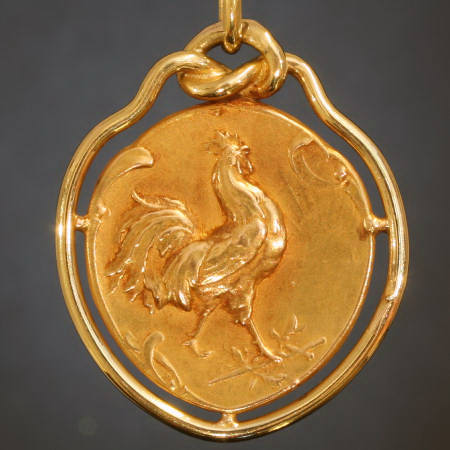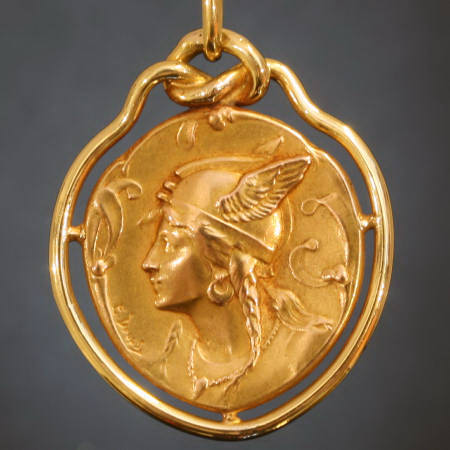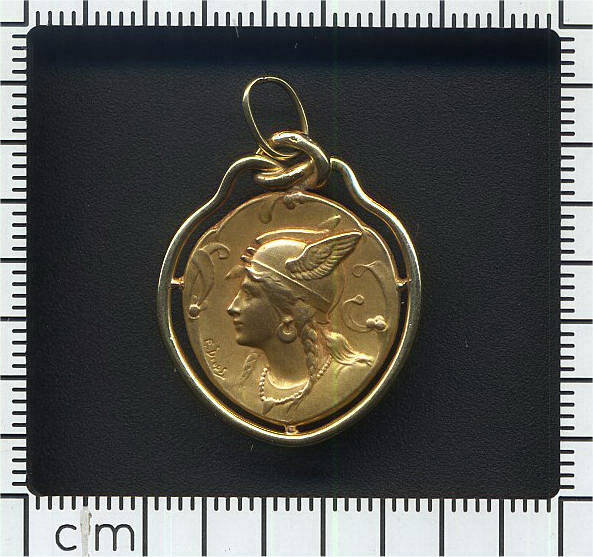We offer layaway, spread payments on the piece of your dreams. Ask us for details. Free insured shipping on all orders !!!
Gold antique pendant rooster and Hermes with winged helmet, signed Dropsy
On one side this signed jewel represents Hermes, also called Mercury, (one of the 12 Olympians) surrounded by mistletoe and on the other side we see the French (or Gallic) Rooster.
Hermes myth - Hermes was Jupiter's son, and was a messenger and guide for the Olympic gods. He was also the god of trade, and protector of travelers, thieves ( :-) ), shepherds and their flocs.The winged petasus, a round hat with shallow ball and the caduceus, a magic wand with two twisting snakes, usually also winged makes him recognizable. With the magic wand he had the power to stimulate sleep. Hermes, god of communication, thought, commerce and travel. He is shown as a beautiful, athletic young man wearing winged sandals and winged helmet, and sometimes carrying a caduceus. Among others he is the father of Pan and Eros.
Mistletoe - From the earliest times mistletoe has been one of the most magical, mysterious, and sacred plants of European folklore. It was considered to bestow life and fertility; a protection against poison; and an aphrodisiac. Norsemen offer us a beautiful symbolic myth about mistletoe. The story goes that Mistletoe was the sacred plant of Frigga, Goddess of love and the mother of Balder, the God of the summer sun. Since his mother was so afraid something would happen to Balder, she made a pact with air, fire, water, earth, and every animal and plant on earth. She forgot however one plant, the mistletoe, which Balder’s only enemy, Loki, God of evil, soon realized. He had Balder shot dead by an arrow tip with a mistletoe attached to it. For three days each element tried to bring Balder back to life. He was finally brought back to life by Frigga, the goddess, and his mother.
It is said the tears she shed for her son turned into the pearly white berries on the mistletoe plant and in her joy Frigga kissed everyone who passed beneath the tree on which it grew. The story ends with a decree that who should ever stand under the humble mistletoe, no harm should befall them, only a kiss, a token of love.
The Gallic rooster - The Latin word Gallus means both "rooster" and "inhabitant of Gaul". Certain ancient coins bore a rooster, but the animal was not yet used as the emblem of the tribes of Gaul. Gradually the figure of the rooster became the most widely shared representation of the French people.
Object group: pendants
Country of origin: Although it does not carry any legible control marks we believe it is of French or Belgian origin.
Style: late-Victorian early
Art Nouveau
- (styles overview)
Style specifics: The style of this jewel announces the coming of the Art-Nouveau style.
Period: ca. 1900 (events and facts in 1900)
Source of inspiration: mother nature and mythology
Material: 18K bi-color (yellow and red)
gold
- (precious metals)
Hallmarks: Illegible remains.
- (general hallmarks info)
Condition: excellent condition
- (our condition scale)
Dimensions: Width approx. 2.20 cm (0.87 inch)
Weight: 2.10 gram (1.35 dwt)
Reference: Nº 08199-4430(or click here)
See also our:
victorian pendants
art nouveau pendants
victorian jewelry
art nouveau jewelry
pendants
jewelry with human face
jewelry with human motifs
mistletoe
all floral jewelry
mythological jewelry
jewelry signed dropsy
all signed jewelry
jewelry with birds
jewelry with animals
latest acquisitions
Additional information:
jewelry glossary.
wall of fame
visit us in Antwerp
subscribe to our mailinglist







